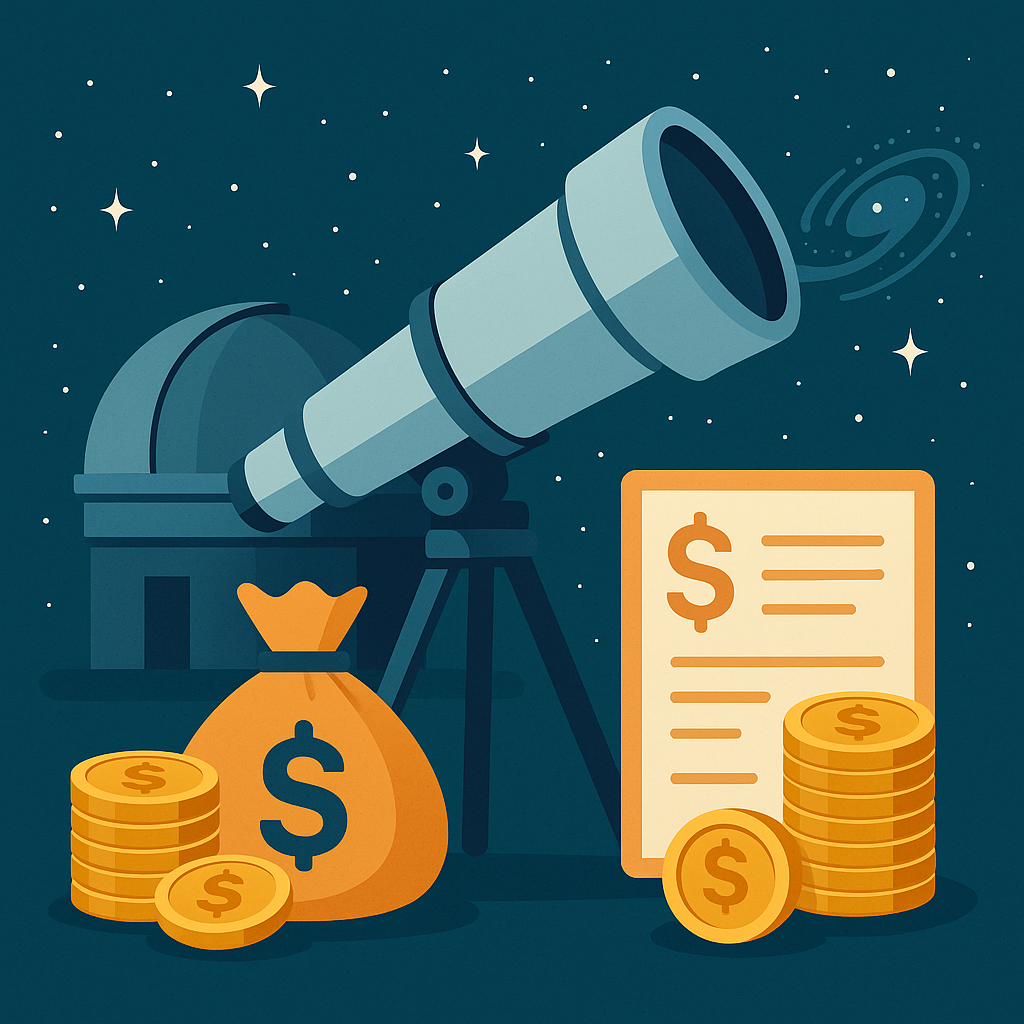🌌 별을 보는 데 드는 돈, 얼마나 될까?
천문학은 낭만적인 분야처럼 보이지만, 망원경 하나 돌리기 위해 들어가는 돈은 결코 낭만적이지 않다. 별빛은 공짜지만, 별빛을 잡아내는 장비는 절대 공짜가 아니다.
💰 망원경은 그냥 ‘비싼 카메라’가 아니다
일반인이 쓰는 천체망원경은 수십만 원부터 시작하지만, 연구용 망원경은 단위가 달라진다.
예를 들어, 허블 우주망원경 개발·발사·운영까지 포함한 총 비용은 약 160억 달러(한화 약 21조 원).
제임스 웹 우주망원경은 약 100억 달러(13조 원)로 시작했지만, 발사 지연과 업그레이드로 실제 총액은 더 커졌다.
이쯤 되면 “망원경 한 번 쓸 때마다 아파트 단지를 통째로 바꾸는 기분”이라는 농담이 괜히 나오는 게 아니다.
🏗 돈이 장비에만 드는 건 아니다
망원경은 설치만 하면 끝이 아니다. 거대한 돔 형태의 관측소 건설, 안정적인 전력 공급, 데이터 저장 서버, 유지·보수 인력까지 포함하면 운영비도 천문학적이다. 칠레 아타카마 사막의 거대 마젤란 망원경(GMT)은 완공 후 연간 운영비만 수백억 원이다.
즉, ‘별을 보기 위한 돈’은 망원경 값 + 건물 + 전기세 + 서버비 + 연구팀 급여 + 커피값(?)까지 합산된다.
🚀 우주로 올라가면 단가 상승
지상 관측도 비싸지만, 우주로 나가면 얘기가 달라진다. 로켓 발사 비용은 1kg당 수천만 원이 기본이다. 장비 수 톤을 올리면 발사비만 수천억 원. 그래서 과학자들이 장비 무게를 줄이기 위해 뼈를 깎는 이유는 관측 성능뿐 아니라 발사비 절감이다.
🌍 국가별 투자 규모
미국 NASA의 2024년 예산은 약 277억 달러(37조 원)로, 그중 약 10%가 천문학과 우주과학 연구에 쓰인다. 유럽우주국(ESA)은 연간 약 70억 유로(10조 원), 일본 JAXA는 약 2조 원을 투자한다. 한국도 KASI(한국천문연구원)와 우주망원경 개발 사업에 수천억 원을 투입 중이다.
국가별 차이는 있지만, 한 가지 공통점은 있다. ‘천문학 투자’는 단순히 별을 보기 위한 돈이 아니라, 과학·산업·기술·교육 전반에 파급되는 종합 투자라는 점이다.
🌠 왜 이렇게 비쌀까?
천문학 장비는 맞춤 제작이 기본이다. 시중 제품을 사는 게 아니라, 연구 목적에 맞춰 설계·제작해야 한다. 부품 하나 고장 나면 지구 반대편 사막이나 우주 한가운데까지 가서 수리해야 하니, 그 자체가 모험이자 비용이다.
🤣 마무리 농담
천문학 예산을 보면, 별을 관찰하는 게 아니라 돈을 우주로 쏘아 올리는 기분이 들 때가 있다. 하지만 그 덕분에 인류는 우주의 기원, 행성의 탄생, 생명 가능성에 더 가까워진다.
과학자들의 지갑은 가벼워져도, 인류의 지식 창고는 점점 무거워진다.
집에서 천체관측을 시작하려면 걱정 말자. 필요한 건 수십조 원이 아니라, 한 장의 돗자리와 한 잔의 커피면 충분하다.
음소분석코너
1. amateur
• 뜻: 아마추어, 비전문가 (취미로 하는 사람)
• 발음기호:
영국식 /ˈæm.ə.tʃə/
미국식 /ˈæm.ə.tʃɚ/ 또는 /ˈæm.ə.tʊr/
• 강세: 첫 음절 **am-**에 강세
• 음소분석 (미국식 /ˈæm.ə.tʃɚ/)
/ˈæm/ — 강세, /æ/ (cat의 a처럼 입을 크게 벌려 내는 단모음) + /m/ 양순 비음
/ə/ — 중성모음, 힘을 빼고 발음
/tʃ/ — 무성 치경구개 파찰음, ch와 같은 소리
/ɚ/ — 미국식 r-발음 포함된 중성모음
2. The Giant Magellan Telescope
• 뜻: 거대 마젤란 망원경 (칠레에 건설 중인 초대형 지상 망원경)
• 발음기호: /ðə ˈdʒaɪənt məˈɡel.ən ˈtel.əˌskoʊp/
• 강세: Giant의 첫 음절 gi-, Magellan의 두 번째 음절 -gel-, Telescope의 첫 음절 **tel-**에 강세
• 음소분석
The /ðə/ — 모음 앞에서는 /ði/로 발음, 여기선 자음으로 시작하니 /ðə/
Giant /ˈdʒaɪənt/ — /ˈdʒ/ (job의 j 소리) + /aɪ/ (my의 i) + /ənt/
Magellan /məˈɡel.ən/ — /mə/ 약하게, /ˈɡel/ 강세, /ən/ 약하게
Telescope /ˈtel.əˌskoʊp/ — /ˈtel/ 강세, /ə/ 약하게, /skoʊp/ (scope) 길게

🌌 How Much Does It Cost to Look at the Stars?
Astronomy sounds romantic, but the price tag for turning a single telescope is anything but. Starlight may be free, but the equipment to catch it definitely isn’t.
💰 A Telescope Isn’t Just an Expensive Camera
While amateur telescopes start from a few hundred dollars, research-grade instruments play in a different league.
For example, the Hubble Space Telescope cost about $16 billion USD in total, including development, launch, and operations.
The James Webb Space Telescope started at $10 billion but ballooned further due to launch delays and upgrades. At that point, scientists joke that “every observation costs as much as replacing an entire apartment complex.”
🏗 It’s Not Just About the Hardware
A telescope is far from “set it and forget it.” You need a massive dome-shaped observatory, stable power supply, data servers, and maintenance staff — all of which push the operating costs into astronomical territory. The Giant Magellan Telescope (GMT) in Chile’s Atacama Desert will require hundreds of millions of dollars annually after completion.
In other words, the “cost of seeing the stars” is the telescope price + building costs + electricity bills + server fees + researcher salaries + coffee.
🚀 Going to Space? Multiply the Price
Ground-based observation is expensive enough, but space missions take it further. Rocket launches cost tens of thousands of dollars per kilogram. Lifting several tons of equipment means launch costs alone run into the billions. This is why scientists work tirelessly to make instruments lighter — to save both performance and launch expenses.
🌍 Budgets by Country
NASA’s 2024 budget is about $27.7 billion USD, with around 10% going to astronomy and space science. The European Space Agency (ESA) spends about €7 billion annually, and Japan’s JAXA invests roughly $1.5 billion USD. South Korea’s KASI (Korea Astronomy and Space Science Institute) and its space telescope projects also receive hundreds of millions of dollars in funding.
Though numbers vary, one fact is clear: astronomy funding is not just about looking at stars — it’s a comprehensive investment in science, industry, technology, and education.
🌠 Why So Expensive?
Astronomy instruments are almost always custom-made. You can’t just buy them off the shelf; they must be designed and built for specific research goals. If a single part fails, repairs may require traveling to a desert on the other side of the world — or even to space — making each fix both an adventure and a major expense.
🤣 A Light-Hearted Ending
Looking at astronomy budgets, it sometimes feels like we’re launching money into space rather than telescopes. But thanks to these investments, humanity moves closer to understanding the origin of the universe, the birth of planets, and the possibility of life elsewhere.
Scientists’ wallets may get lighter, but humanity’s library of knowledge grows heavier.
And if you want to start stargazing at home, don’t worry — you won’t need billions. Just grab a blanket and a cup of coffee.
#천문학예산 #망원경가격 #우주과학투자 #제임스웹망원경 #허블망원경 #국가별투자 #과학기술발전 #우주연구비용 #천문학비용 #과학유머